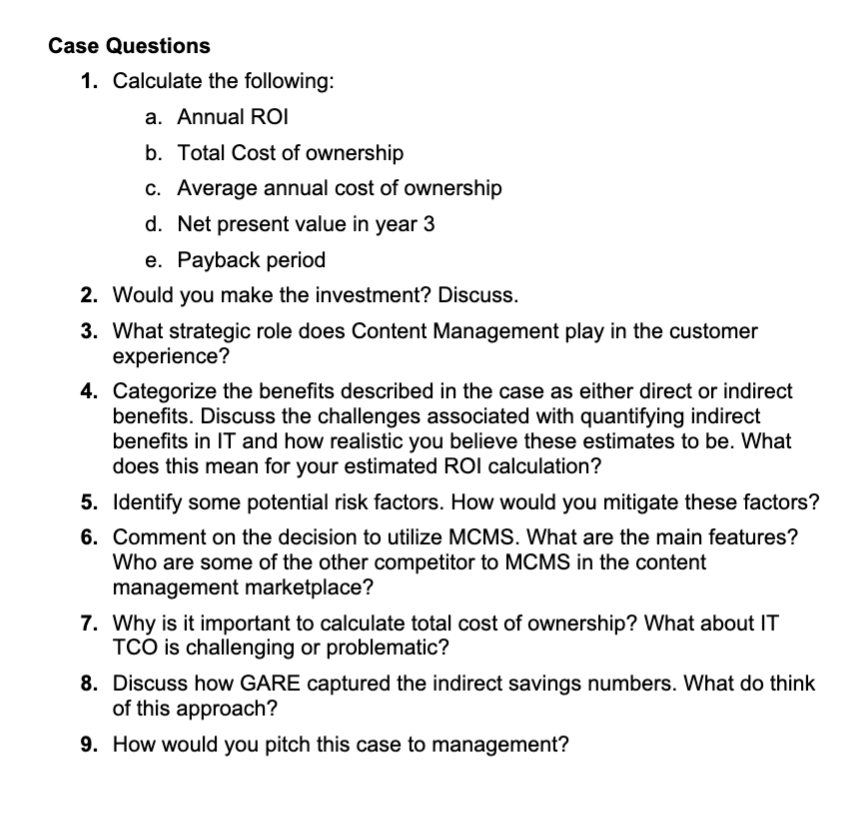
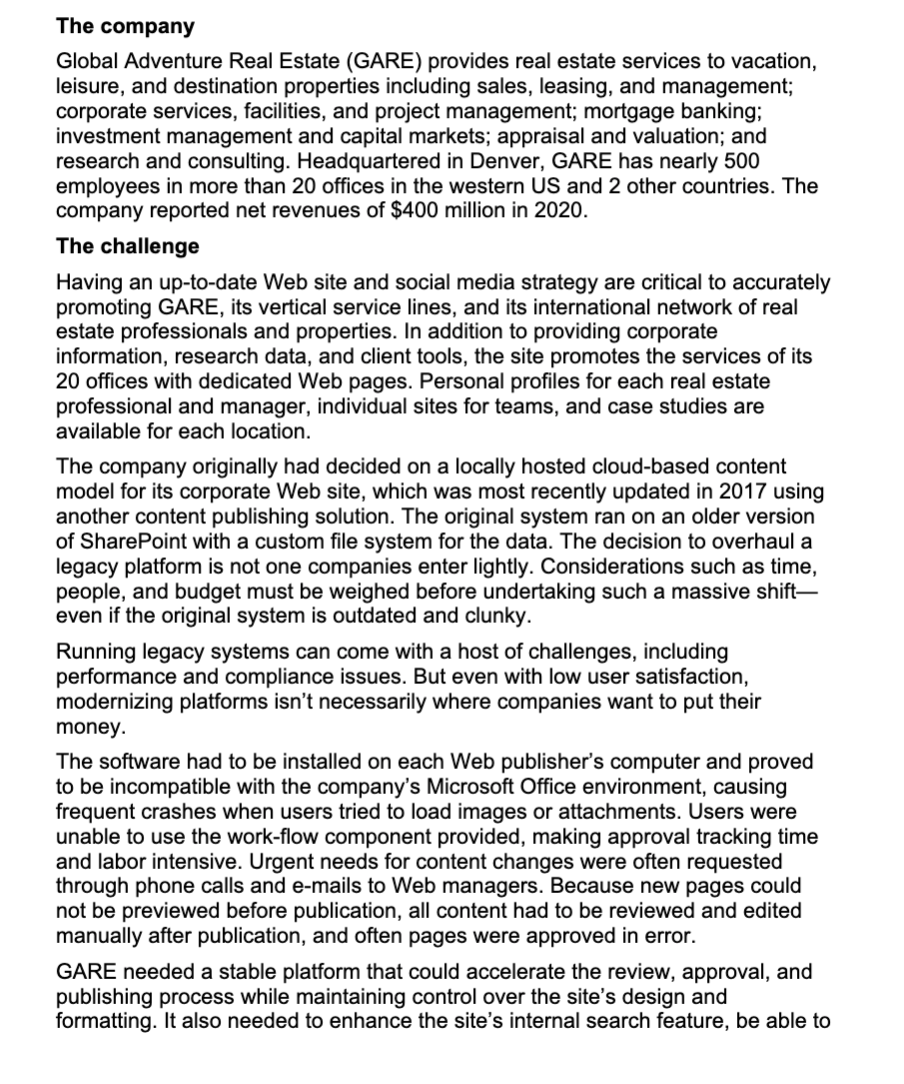
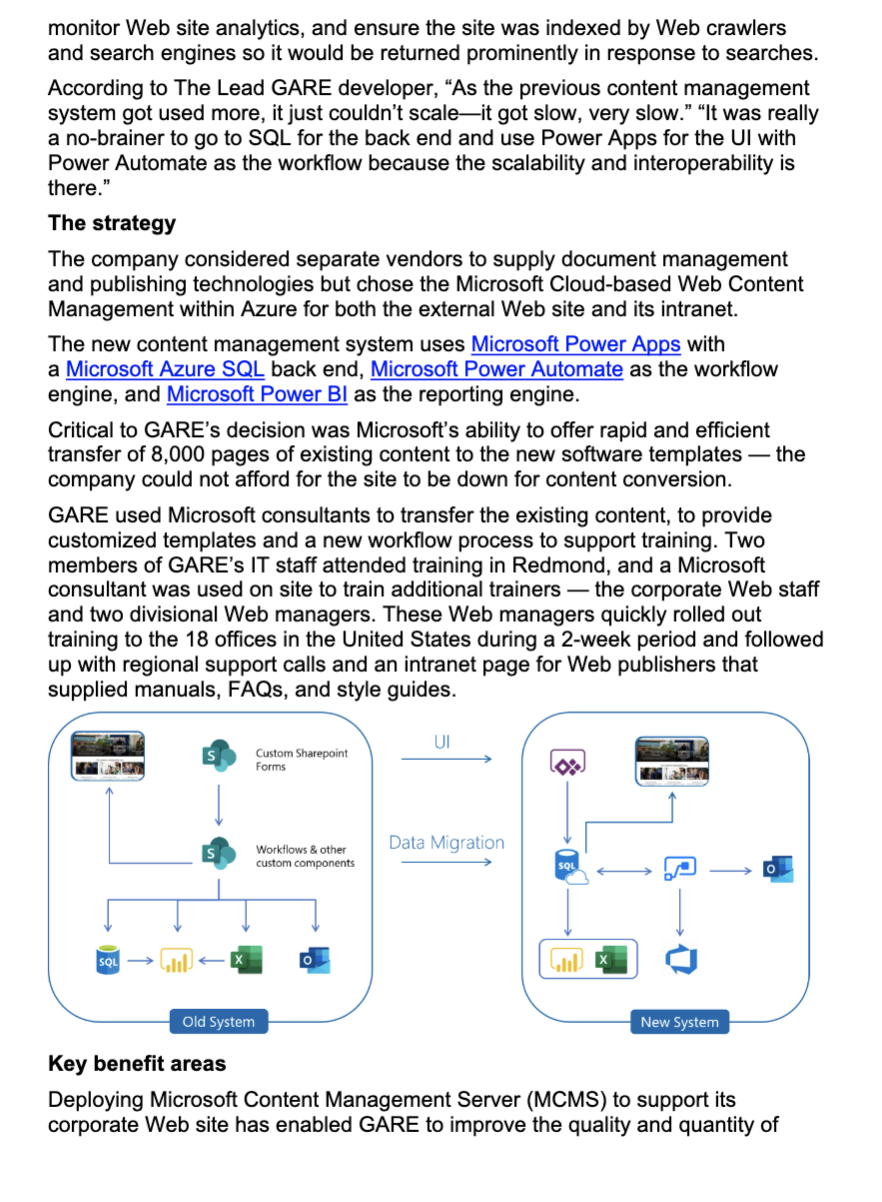
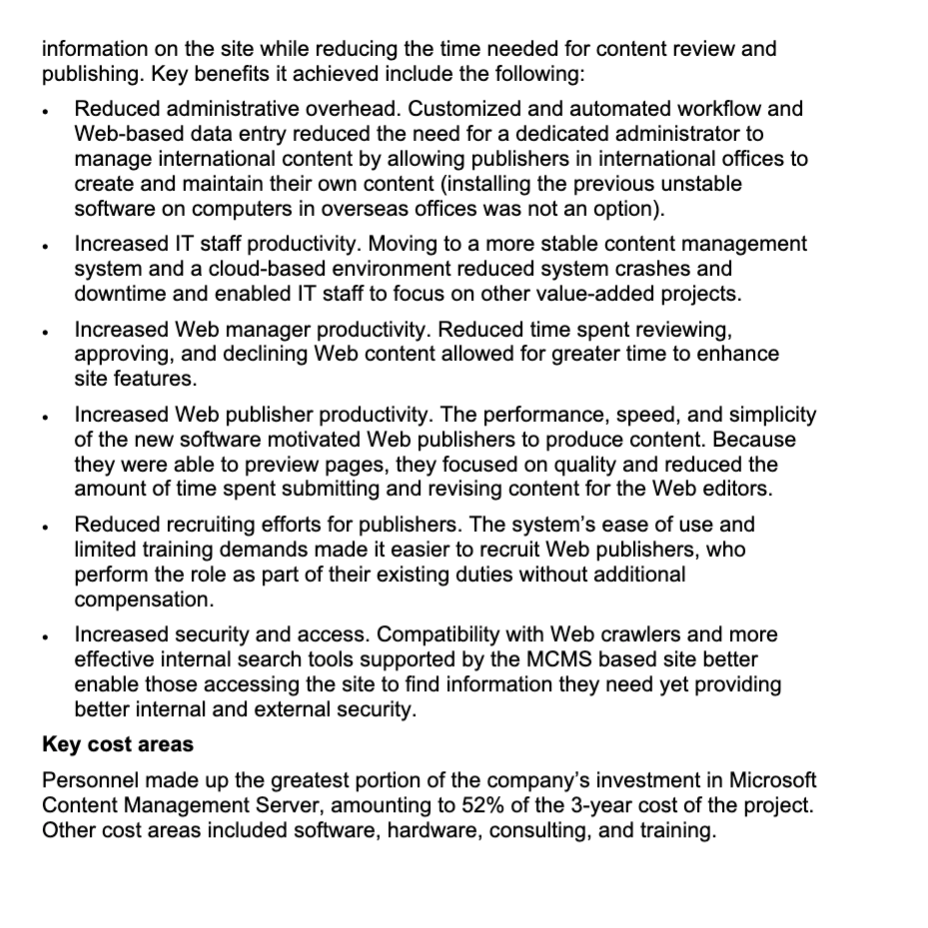
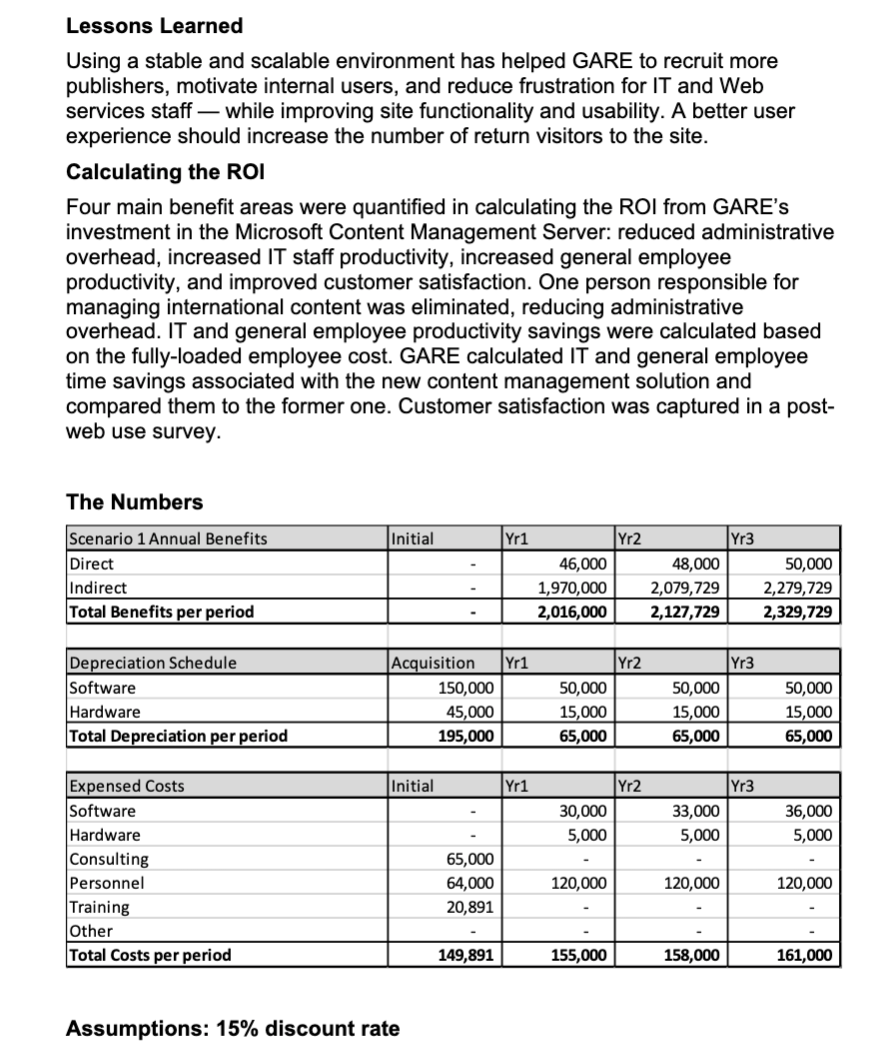
Case Questions 1. Calculate the following: a. Annual ROI b. Total Cost of ownership c. Average annual cost of ownership d. Net present value in year 3 e. Payback period 2. Would you make the investment? Discuss. 3. What strategic role does Content Management play in the customer experience? 4. Categorize the benefits described in the case as either direct or indirect benefits. Discuss the challenges associated with quantifying indirect benefits in IT and how realistic you believe these estimates to be. What does this mean for your estimated ROI calculation? 5. Identify some potential risk factors. How would you mitigate these factors? 6. Comment on the decision to utilize MCMS. What are the main features? Who are some of the other competitor to MCMS in the content management marketplace? 7. Why is it important to calculate total cost of ownership? What about IT TCO is challenging or problematic? 8. Discuss how GARE captured the indirect savings numbers. What do think of this approach? 9. How would you pitch this case to management? The company Global Adventure Real Estate (GARE) provides real estate services to vacation, leisure, and destination properties including sales, leasing, and management; corporate services, facilities, and project management; mortgage banking; investment management and capital markets; appraisal and valuation; and research and consulting. Headquartered in Denver, GARE has nearly 500 employees in more than 20 offices in the western US and 2 other countries. The company reported net revenues of $400 million in 2020. The challenge Having an up-to-date Web site and social media strategy are critical to accurately promoting GARE, its vertical service lines, and its international network of real estate professionals and properties. In addition to providing corporate information, research data, and client tools, the site promotes the services of its 20 offices with dedicated Web pages. Personal profiles for each real estate professional and manager, individual sites for teams, and case studies are available for each location. The company originally had decided on a locally hosted cloud-based content model for its corporate Web site, which was most recently updated in 2017 using another content publishing solution. The original system ran on an older version of SharePoint with a custom file system for the data. The decision to overhaul a legacy platform is not one companies enter lightly. Considerations such as time, people, and budget must be weighed before undertaking such a massive shift- even if the original system is outdated and clunky. Running legacy systems can come with a host of challenges, including performance and compliance issues. But even with low user satisfaction, modernizing platforms isn't necessarily where companies want to put their money. The software had to be installed on each Web publisher's computer and proved to be incompatible with the company's Microsoft Office environment, causing frequent crashes when users tried to load images or attachments. Users were unable to use the work-flow component provided, making approval tracking time and labor intensive. Urgent needs for content changes were often requested through phone calls and e-mails to Web managers. Because new pages could not be previewed before publication, all content had to be reviewed and edited manually after publication, and often pages were approved in error. GARE needed a stable platform that could accelerate the review, approval, and publishing process while maintaining control over the site's design and formatting. It also needed to enhance the site's internal search feature, be able to monitor Web site analytics, and ensure the site was indexed by Web crawlers and search engines so it would be returned prominently in response to searches. According to The Lead GARE developer, As the previous content management system got used more, it just couldn't scaleit got slow, very slow. It was really a no-brainer to go to SQL for the back end and use Power Apps for the UI with Power Automate as the workflow because the scalability and interoperability is there." The strategy The company considered separate vendors to supply document management and publishing technologies but chose the Microsoft Cloud-based Web Content Management within Azure for both the external Web site and its intranet. The new content management system uses Microsoft Power Apps with a Microsoft Azure SQL back end, Microsoft Power Automate as the workflow engine, and Microsoft Power Bl as the reporting engine. Critical to GARE's decision was Microsoft's ability to offer rapid and efficient transfer of 8,000 pages of existing content to the new software templates the company could not afford for the site to be down for content conversion. GARE used Microsoft consultants to transfer the existing content, to provide customized templates and a new workflow process to support training. Two members of GARE's IT staff attended training in Redmond, and a Microsoft consultant was used on site to train additional trainers the corporate Web staff and two divisional Web managers. These Web managers quickly rolled out training to the 18 offices in the United States during a 2-week period and followed up with regional support calls and an intranet page for Web publishers that supplied manuals, FAQs, and style guides. UI Custom Sharepoint Forms OS Data Migration Workflows & other custom components SQL SQL Old System New System Key benefit areas Deploying Microsoft Content Management Server (MCMS) to support its corporate Web site has enabled GARE to improve the quality and quantity of information on the site while reducing the time needed for content review and publishing. Key benefits it achieved include the following: Reduced administrative overhead. Customized and automated workflow and Web-based data entry reduced the need for a dedicated administrator to manage international content by allowing publishers in international offices to create and maintain their own content (installing the previous unstable software on computers in overseas offices was not an option). Increased IT staff productivity. Moving to a more stable content management system and a cloud-based environment reduced system crashes and downtime and enabled IT staff to focus on other value-added projects. Increased Web manager productivity. Reduced time spent reviewing, approving, and declining Web content allowed for greater time to enhance site features. Increased Web publisher productivity. The performance, speed, and simplicity of the new software motivated Web publishers to produce content. Because they were able to preview pages, they focused on quality and reduced the amount of time spent submitting and revising content for the Web editors. Reduced recruiting efforts for publishers. The system's ease of use and limited training demands made it easier to recruit Web publishers, who perform the role as part of their existing duties without additional compensation. Increased security and access. Compatibility with Web crawlers and more effective internal search tools supported by the MCMS based site better enable those accessing the site to find information they need yet providing better internal and external security. Key cost areas Personnel made up the greatest portion of the company's investment in Microsoft Content Management Server, amounting to 52% of the 3-year cost of the project. Other cost areas included software, hardware, consulting, and training. Lessons Learned Using a stable and scalable environment has helped GARE to recruit more publishers, motivate internal users, and reduce frustration for IT and Web services staff while improving site functionality and usability. A better user experience should increase the number of return visitors to the site. Calculating the ROI Four main benefit areas were quantified in calculating the ROI from GARE's investment in the Microsoft Content Management Server: reduced administrative overhead, increased IT staff productivity, increased general employee productivity, and improved customer satisfaction. One person responsible for managing international content was eliminated, reducing administrative overhead. IT and general employee productivity savings were calculated based on the fully-loaded employee cost. GARE calculated IT and general employee time savings associated with the new content management solution and compared them to the former one. Customer satisfaction was captured in a post- web use survey. The Numbers Initial Scenario 1 Annual Benefits Direct Indirect Total Benefits per period Yr1 Yr2 Yr3 46,000 48,000 50,000 1,970,000 2,079,729 2,279,729 2,016,000 2,127,729 2,329,729 Yr1 Depreciation Schedule Software Hardware Total Depreciation per period Acquisition 150,000 45,000 195,000 Yr2 50,000 15,000 65,000 Yr3 50,000 15,000 65,000 50,000 15,000 65,000 Initial Yr1 Yr2 Yr3 30,000 5,000 33,000 5,000 36,000 5,000 Expensed Costs Software Hardware Consulting Personnel Training Other Total Costs per period 65,000 64,000 20,891 120,000 120,000 120,000 149,891 155,000 158,000 161,000 Assumptions: 15% discount rate Case Questions 1. Calculate the following: a. Annual ROI b. Total Cost of ownership c. Average annual cost of ownership d. Net present value in year 3 e. Payback period 2. Would you make the investment? Discuss. 3. What strategic role does Content Management play in the customer experience? 4. Categorize the benefits described in the case as either direct or indirect benefits. Discuss the challenges associated with quantifying indirect benefits in IT and how realistic you believe these estimates to be. What does this mean for your estimated ROI calculation? 5. Identify some potential risk factors. How would you mitigate these factors? 6. Comment on the decision to utilize MCMS. What are the main features? Who are some of the other competitor to MCMS in the content management marketplace? 7. Why is it important to calculate total cost of ownership? What about IT TCO is challenging or problematic? 8. Discuss how GARE captured the indirect savings numbers. What do think of this approach? 9. How would you pitch this case to management? The company Global Adventure Real Estate (GARE) provides real estate services to vacation, leisure, and destination properties including sales, leasing, and management; corporate services, facilities, and project management; mortgage banking; investment management and capital markets; appraisal and valuation; and research and consulting. Headquartered in Denver, GARE has nearly 500 employees in more than 20 offices in the western US and 2 other countries. The company reported net revenues of $400 million in 2020. The challenge Having an up-to-date Web site and social media strategy are critical to accurately promoting GARE, its vertical service lines, and its international network of real estate professionals and properties. In addition to providing corporate information, research data, and client tools, the site promotes the services of its 20 offices with dedicated Web pages. Personal profiles for each real estate professional and manager, individual sites for teams, and case studies are available for each location. The company originally had decided on a locally hosted cloud-based content model for its corporate Web site, which was most recently updated in 2017 using another content publishing solution. The original system ran on an older version of SharePoint with a custom file system for the data. The decision to overhaul a legacy platform is not one companies enter lightly. Considerations such as time, people, and budget must be weighed before undertaking such a massive shift- even if the original system is outdated and clunky. Running legacy systems can come with a host of challenges, including performance and compliance issues. But even with low user satisfaction, modernizing platforms isn't necessarily where companies want to put their money. The software had to be installed on each Web publisher's computer and proved to be incompatible with the company's Microsoft Office environment, causing frequent crashes when users tried to load images or attachments. Users were unable to use the work-flow component provided, making approval tracking time and labor intensive. Urgent needs for content changes were often requested through phone calls and e-mails to Web managers. Because new pages could not be previewed before publication, all content had to be reviewed and edited manually after publication, and often pages were approved in error. GARE needed a stable platform that could accelerate the review, approval, and publishing process while maintaining control over the site's design and formatting. It also needed to enhance the site's internal search feature, be able to monitor Web site analytics, and ensure the site was indexed by Web crawlers and search engines so it would be returned prominently in response to searches. According to The Lead GARE developer, As the previous content management system got used more, it just couldn't scaleit got slow, very slow. It was really a no-brainer to go to SQL for the back end and use Power Apps for the UI with Power Automate as the workflow because the scalability and interoperability is there." The strategy The company considered separate vendors to supply document management and publishing technologies but chose the Microsoft Cloud-based Web Content Management within Azure for both the external Web site and its intranet. The new content management system uses Microsoft Power Apps with a Microsoft Azure SQL back end, Microsoft Power Automate as the workflow engine, and Microsoft Power Bl as the reporting engine. Critical to GARE's decision was Microsoft's ability to offer rapid and efficient transfer of 8,000 pages of existing content to the new software templates the company could not afford for the site to be down for content conversion. GARE used Microsoft consultants to transfer the existing content, to provide customized templates and a new workflow process to support training. Two members of GARE's IT staff attended training in Redmond, and a Microsoft consultant was used on site to train additional trainers the corporate Web staff and two divisional Web managers. These Web managers quickly rolled out training to the 18 offices in the United States during a 2-week period and followed up with regional support calls and an intranet page for Web publishers that supplied manuals, FAQs, and style guides. UI Custom Sharepoint Forms OS Data Migration Workflows & other custom components SQL SQL Old System New System Key benefit areas Deploying Microsoft Content Management Server (MCMS) to support its corporate Web site has enabled GARE to improve the quality and quantity of information on the site while reducing the time needed for content review and publishing. Key benefits it achieved include the following: Reduced administrative overhead. Customized and automated workflow and Web-based data entry reduced the need for a dedicated administrator to manage international content by allowing publishers in international offices to create and maintain their own content (installing the previous unstable software on computers in overseas offices was not an option). Increased IT staff productivity. Moving to a more stable content management system and a cloud-based environment reduced system crashes and downtime and enabled IT staff to focus on other value-added projects. Increased Web manager productivity. Reduced time spent reviewing, approving, and declining Web content allowed for greater time to enhance site features. Increased Web publisher productivity. The performance, speed, and simplicity of the new software motivated Web publishers to produce content. Because they were able to preview pages, they focused on quality and reduced the amount of time spent submitting and revising content for the Web editors. Reduced recruiting efforts for publishers. The system's ease of use and limited training demands made it easier to recruit Web publishers, who perform the role as part of their existing duties without additional compensation. Increased security and access. Compatibility with Web crawlers and more effective internal search tools supported by the MCMS based site better enable those accessing the site to find information they need yet providing better internal and external security. Key cost areas Personnel made up the greatest portion of the company's investment in Microsoft Content Management Server, amounting to 52% of the 3-year cost of the project. Other cost areas included software, hardware, consulting, and training. Lessons Learned Using a stable and scalable environment has helped GARE to recruit more publishers, motivate internal users, and reduce frustration for IT and Web services staff while improving site functionality and usability. A better user experience should increase the number of return visitors to the site. Calculating the ROI Four main benefit areas were quantified in calculating the ROI from GARE's investment in the Microsoft Content Management Server: reduced administrative overhead, increased IT staff productivity, increased general employee productivity, and improved customer satisfaction. One person responsible for managing international content was eliminated, reducing administrative overhead. IT and general employee productivity savings were calculated based on the fully-loaded employee cost. GARE calculated IT and general employee time savings associated with the new content management solution and compared them to the former one. Customer satisfaction was captured in a post- web use survey. The Numbers Initial Scenario 1 Annual Benefits Direct Indirect Total Benefits per period Yr1 Yr2 Yr3 46,000 48,000 50,000 1,970,000 2,079,729 2,279,729 2,016,000 2,127,729 2,329,729 Yr1 Depreciation Schedule Software Hardware Total Depreciation per period Acquisition 150,000 45,000 195,000 Yr2 50,000 15,000 65,000 Yr3 50,000 15,000 65,000 50,000 15,000 65,000 Initial Yr1 Yr2 Yr3 30,000 5,000 33,000 5,000 36,000 5,000 Expensed Costs Software Hardware Consulting Personnel Training Other Total Costs per period 65,000 64,000 20,891 120,000 120,000 120,000 149,891 155,000 158,000 161,000 Assumptions: 15% discount rate











